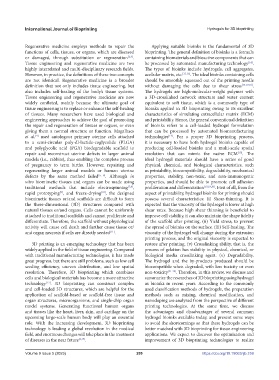Page 217 - IJB-9-5
P. 217
International Journal of Bioprinting Hydrogels for 3D bioprinting
Regenerative medicine employs methods to repair the Applying suitable bioinks is the fundamental of 3D
functions of cells, tissues, or organs, which are diseased bioprinting. The general definition of bioinks is a formula
or damaged, through substitution or regeneration [2,3] . containing biomaterials and bioactive components that can
Tissue engineering and regenerative medicine are two be processed by automated manufacturing technology .
[14]
highly interrelated and multi-disciplinary research fields. The types of bioinks include hydrogels, cell aggregates,
However, in practice, the definitions of these two concepts acellular matrix, etc. [15,16] . The ideal bioinks containing cells
are not identical. Regenerative medicine is a broader should be smoothly squeezed out of the printing needle
definition that not only includes tissue engineering, but without damaging the cells due to shear stress [14,17,18] .
also includes self-healing of the body’s tissue systems. The hydrogels are high-molecular-weight polymer with
Tissue engineering and regenerative medicine are now a 3D-crosslinked network structure and water content
widely conflated, mainly because the ultimate goal of equivalent to soft tissue, which is a commonly type of
tissue engineering is to replace or enhance the self-healing bioinks applied in 3D bioprinting owing to its excellent
of tissues. Many researchers have used biological and characteristics of simulating extracellular matrix (ECM)
engineering approaches to achieve the goal of promoting and printability. Hence, the general conventional definition
the repair and regeneration of tissues or organs, or even of bioinks refers to a cell-loaded hydrogel formulation
giving them a normal structure or function. Magalhaes that can be processed by automated biomanufacturing
et al. used autologous primary uterine cells attached technologies . For a proper 3D bioprinting process,
[14]
[4]
to a semi-circular poly-dl-lactide-coglycolide (PLGA) it is necessary to have both hydrogel bioinks capable of
and polyglycolic acid (PGA) biodegradable scaffold to producing cell-loaded bioinks and a multi-scale spatial
repair and reconstruct uterine defects in larger animal resolution that can mimic the native ECM . The
[19]
models (i.e., rabbits), thus enabling the complete process ideal hydrogel materials should have a series of good
of pregnancy to term births. However, repairing and physical, chemical, and biological characteristics, such
regenerating larger animal models or human uterine as printability, biocompatibility, degradability, mechanical
defects by the same method failed [5, 6] . Although in properties, stability, non-toxic, and non-immunogenic
vitro biomimetic tissues and organs can be made using properties, and should be able to promote cell adhesion
traditional methods that include electrospinning [7,8] , proliferation and differentiation [15,19,20] . First of all, from the
rapid prototyping , and freeze-drying , the designed aspect of printability, hydrogel bioinks for printing should
[9]
[10]
biomimetic tissues or/and scaffolds are difficult to form possess several characteristics: (i) Shear-thinning. It is
the three-dimensional (3D) structures compared with expected that the viscosity of the hydrogel is lower at high
natural tissues or/and organs. Cells cannot be uniformly shear rates. Because high shear thinning is beneficial to
attached to traditional scaffolds and cannot proliferate and improve cell viability, it can also maintain the shape fidelity
differentiate. Therefore, the scaffold without physiological of the scaffold after printing. (ii) Yield stress; to prevent
activity will cause cell death and further cause tissue or/ the spread of bioinks on the surface. (iii) Self-healing. The
and organ necrosis if cells are directly seeded . viscosity of the hydrogel will change during the extrusion
[11]
printing process, and the original viscosity is expected to
3D printing is an emerging technology that has been restore after printing. (v) Crosslinking ability, that is, the
widely applied in the field of tissue engineering. Compared process of gelation has stability in physical, chemical, or
with traditional manufacturing technologies, it has made biological media crosslinking agent. (v) Degradability.
great progress, but there are still problems, such as low cell The hydrogel and the by-products produced should be
seeding efficiency, uneven distribution, and low spatial biocompatible when degraded, with less toxicity or even
resolution. Therefore, 3D bioprinting which combines non-toxicity [21-25] . Therefore, in this review, we discuss and
cells and biological materials has become a more attractive summarize the researches of 3D bioprinting using hydrogel
technology . 3D bioprinting can construct complex as bioinks in recent years. According to the commonly
[12]
and cell-loaded 3D structures, which are helpful for the used classification methods of hydrogels, the preparation
application of scaffold-based or scaffold-free tissue and methods such as mixing, chemical modification, and
organ structures, microorganisms, and single-chip organ nanodoping are analyzed from the perspective of different
model systems. Generating functional human organs printing technologies. At the same time, we discuss
and tissues like the heart, liver, skin, and cartilage on the the advantages and disadvantages of several common
upcoming large-scale human body will play an essential hydrogel bioinks available today, and present some ways
role. With the increasing development, 3D bioprinting to avoid the shortcomings so that these hydrogels can be
technology is leading a global revolution in the medical better matched with 3D bioprinting for tissue engineering
field, and enormous changes will take place in the treatment applications. We expect to discover the optimization and
of diseases in the near future [2,13] . improvement of 3D bioprinting technologies to realize
Volume 9 Issue 5 (2023) 209 https://doi.org/10.18063/ijb.759

